Thomas C. McMurtry (June 4, 1935 - January 3, 2015) was an American mechanical engineer, and a former naval aviator, test pilot at NASA's Flight Research Center and a consultant for Lockheed Corporation.
Thomas C. McMurtry (June 4, 1935 - January 3, 2015) was an American mechanical engineer, and a former naval aviator, test pilot at NASA's Flight Research Center and a consultant for Lockheed Corporation.
Born in Crawfordsville, Indiana, on 4 June 1935, McMurtry attended elementary school in Rockville, Indiana, and received his Bachelor of Science degree in mechanical engineering from the University of Notre Dame in June 1957.
A former U.S. Navy pilot and graduate of the United States Naval Test Pilot School, NAS Patuxent River, Maryland, McMurtry was a consultant for Lockheed Corporation before joining NASA in 1967.
McMurtry joined NASA as a research test pilot in 1967. The first project he was assigned to as the project pilot was the F-8 Supercritical Wing project. He flew its first flight on 9 March 1971 and that of the NASA AD-1 on 21 December 1979. He was project pilot on the TF-8A Supercritical Wing testbed and the AD-1. He was co-project pilot on the F-8 Digital Fly-By-Wire Airplane, the 747 Shuttle Carrier Aircraft and performed digital electronic F-15 engine efficiency control tests. On 26 November 1975, the X-24B dropped from the sky for the last time, piloted on its 36th flight by McMurtry. [1]
McMurtry co-piloted the 747 Carrier Aircraft as it transported the Space Shuttle Enterprise to its first launch on 12 August 1977. McMurtry logged over 11,000 hours of flying time since earning his pilot's wings in 1958. A graduate of the United States Naval Test Pilot School, he has flown many aircraft including the U-2, X-24B, F-8A, AD-1, YF-12C, F-104, and F-15. McMurtry became chief research test pilot and then Chief of the Research Aircraft Division for the NASA Ames-Dryden Flight Research Facility. He eventually rose to be the Director for Flight Operations at the NASA Dryden Flight Research Center, and retired on June 3, 1999, after 32 years of service and one day shy of his 64th birthday.
Following his retirement from NASA, McMurtry flew his WACO open cockpit biplane and a Piper Cub.
McMurtry has been honored with the Society of Experimental Test Pilots' Iven C. Kincheloe Award for his work with the AD-1 Oblique Wing Airplane Program in 1982 and received Presidential recognition with the rank of Meritorious Executive in the Senior Executive Service. He was also awarded three NASA Exceptional Service Medals and the Aerospace Walk of Honor. [2]
In 2012 McMurtry was nominated for an award by the Screen Actors Guild. [3] He was Wolfe Air's lead Vectorvision pilot. [4]
In 2014 he accepted the Wright Brothers Master Pilot Award.

Francis Richard “Dick” Scobee was an American pilot, engineer and astronaut. He was killed while he was commanding the Space Shuttle Challenger in 1986, which suffered catastrophic booster failure during launch of the STS-51-L mission.
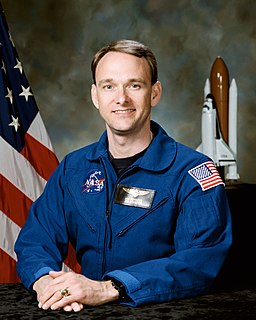
Joe Frank Edwards Jr., , is an American aerospace engineer, and former naval officer and aviator, test pilot and NASA astronaut.

The NASA Neil A. Armstrong Flight Research Center (AFRC) is an aeronautical research center operated by NASA. Its primary campus is located inside Edwards Air Force Base in California and is considered NASA's premier site for aeronautical research. AFRC operates some of the most advanced aircraft in the world and is known for many aviation firsts, including critical support for the first crewed airplane to exceed the speed of sound in level flight with the Bell X-1, highest speed ever recorded by a crewed, powered aircraft, the first pure digital fly-by-wire aircraft, and many others. AFRC also operates a second site in Palmdale, Ca. known as Building 703, once the former Rockwell International/North American Aviation production facility, next to Air Force Plant 42. There, AFRC houses and operates several of NASA's Science Mission Directorate aircraft including SOFIA, a DC-8 Flying Laboratory, a Gulfstream C-20A UAVSAR and ER-2 High Altitude Platform. David McBride is currently the center's director.

Charles Gordon Fullerton was a United States Air Force colonel, a USAF and NASA astronaut, and a research pilot at NASA's Dryden Flight Research Facility, Edwards, California. His assignments included a variety of flight research and support activities piloting NASA's B-52 launch aircraft, the Boeing 747 Shuttle Carrier Aircraft (SCA), and other multi-engine and high performance aircraft.

The Shuttle Carrier Aircraft (SCA) are two extensively modified Boeing 747 airliners that NASA used to transport Space Shuttle orbiters. One is a 747–100 model, while the other is a short range 747-100SR.
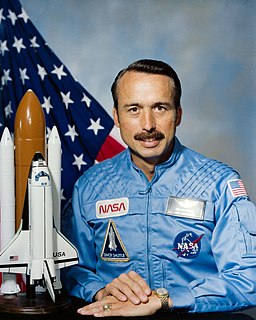
James Craig Adamson is a former NASA astronaut and retired Colonel of the United States Army. He is married with 3 children. James Adamson flew on two missions, STS-28 and STS-43, and completed 263 orbits and 334 hours in space. After retiring from NASA, he was recruited by Allied Signal where he retired in 2001. Adamson has logged over 3,000 hours in over 30 different types of helicopters and airplanes.
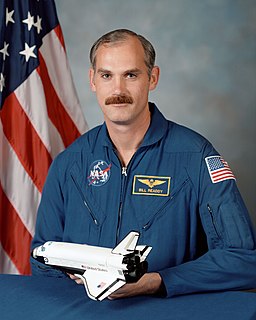
William Francis Readdy is a former Associate Administrator of the Office of Space Flight, at NASA Headquarters.

Joseph Albert Walker was an American World War II pilot, experimental physicist, NASA test pilot, and astronaut. He was one of twelve pilots who flew the North American X-15, an experimental spaceplane jointly operated by the Air Force and NASA.

William Harvey "Bill" Dana was an American aeronautical engineer, U.S. Air Force pilot, NASA test pilot, and astronaut. He was one of twelve pilots who flew the North American X-15, an experimental spaceplane jointly operated by the Air Force and NASA. He was also selected for participation in the X-20 Dyna-Soar program.

Milton Orville Thompson, better known as Milt Thompson, was an American naval officer, aviator, engineer, and NASA research pilot. He was one of twelve pilots who flew the North American X-15, an experimental spaceplane jointly operated by the United States Air Force and NASA. He was also selected for participation in the X-20 Dyna-Soar program.

Bruce A. Peterson was an American aeronautical engineer, and test pilot for NASA.
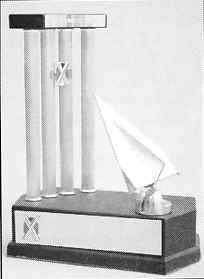
The Iven C. Kincheloe Award recognizes outstanding professional accomplishment in the conduct of flight testing. It was established in 1958 by the Society of Experimental Test Pilots in memory of test pilot and Korean War ace Iven C. Kincheloe, United States Air Force, who died during flight testing.
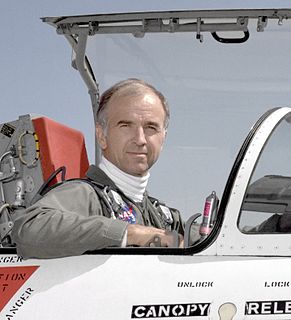
Einar K. Enevoldson was the director of the Perlan Project. He was a civilian research pilot for NASA's Hugh L. Dryden Flight Research Center, Edwards, California, from 1968 until 1986. He was involved in many research programs, including those with experimental wings, propulsion and digital computer flight control systems.

The NASA AD-1 was both an aircraft and an associated flight test program conducted between 1979 and 1982 at the NASA Dryden Flight Research Center, Edwards California, which successfully demonstrated an aircraft wing that could be pivoted obliquely from zero to 60 degrees during flight.

Richard Eben Gray was a Naval aviator for the United States Navy, and latterly a research test pilot. He was born in Newport News, Virginia. He graduated with a Bachelor of Science degree in aeronautical engineering from San Jose State University in 1969 on a scholarship from the Society of Experimental Test Pilots (SETP), of which his father, William E. Gray, had been a member. Gray himself became a member of SETP in the mid-1970s and served on the SETP Board of Directors as Southwest Section Technical Adviser in 1981/1982.
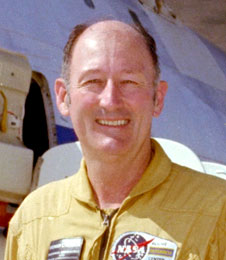
Fitzhugh L. "Fitz" Fulton, Jr., , was a civilian research pilot at NASA's Dryden Flight Research Center, Edwards, California, from August 1, 1966, until July 3, 1986, following 23 years of distinguished service as a pilot in the U.S. Air Force.

The Approach and Landing Tests were a series of taxi and flight trials of the prototype Space Shuttle Enterprise, conducted in 1977 to test the vehicle's flight characteristics both on its own and when mated to the Shuttle Carrier Aircraft, prior to the operational debut of the Shuttle system.

Donald L. Mallick is an American former pilot at the NASA Dryden Flight Research Center from 1963 to 1981. He later became the deputy chief for the Dryden Aircraft Operations Division.

Walter Charles Williams was an American engineer, leader of the National Advisory Committee for Aeronautics (NACA) group at Edwards Air Force Base in the 1940s and 1950s, and a NASA deputy associate administrator during Project Mercury.
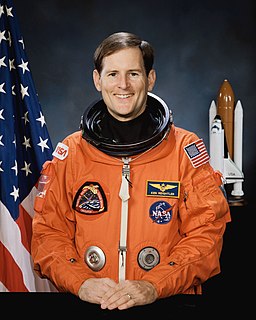
Kenneth Stanley Reightler Jr. is a former NASA astronaut.